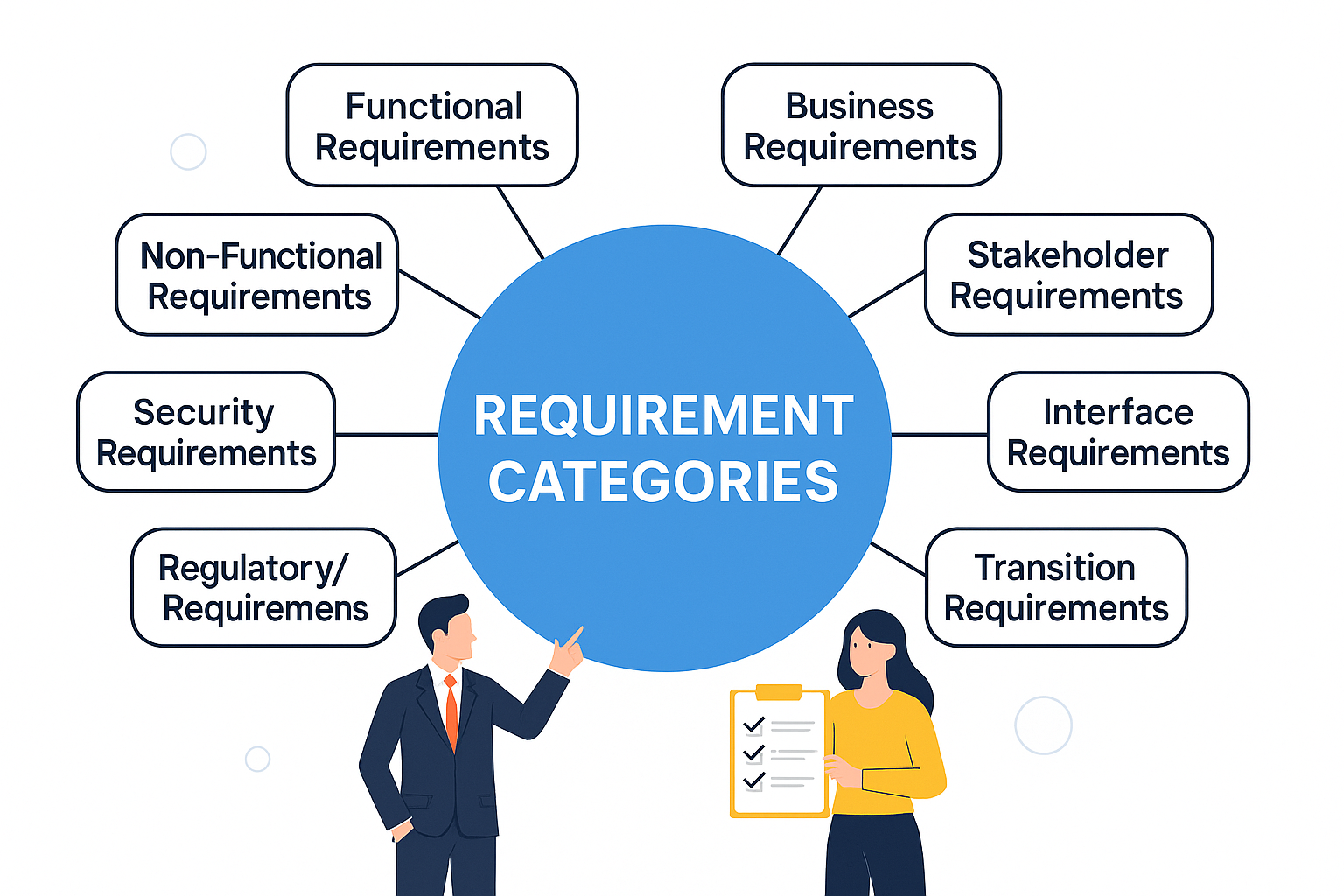
In the world of business analysis, requirements gathering is more than just collecting stakeholder wishes—it’s about understanding, organizing, and categorizing those needs to guide a project’s success. Whether you’re implementing a CRM system or launching a mobile app, categorizing your requirements ensures alignment, clarity, and traceability throughout the project lifecycle.
In this blog post, we’ll explore why categorizing requirements matters, and walk through 16 essential requirement categories every Business Analyst should be familiar with.
Why Categorize Requirements?
Categorizing requirements during elicitation and analysis isn’t just best practice—it’s critical to project success. Here’s why:
1. Improves Clarity and Organization
It helps manage large volumes of requirements by structuring them logically. This makes them easier to read, review, and validate.
2. Enhances Stakeholder Communication
Each stakeholder group (executives, developers, testers) focuses on different types of requirements. Categorization enables tailored discussions.
3. Aids Traceability and Prioritization
Well-categorized requirements support tools like the Requirement Traceability Matrix (RTM) and MoSCoW prioritization, ensuring no requirement is missed or misaligned.
4. Ensures Full Coverage
Categorizing helps uncover gaps. For example, are we considering security, compliance, or usability? If it’s not categorized, it may be overlooked.
The 16 Most Important Requirement Categories
Here’s a comprehensive breakdown of the categories, complete with definitions and real-world examples:
| Category | Description | Example |
|---|---|---|
| Business Requirements | High-level goals of the business or project sponsor. | Improve user retention by 20%. |
| Stakeholder Requirements | Needs and expectations from stakeholders or departments. | Marketing team wants real-time analytics. |
| Functional Requirements | Specific features or functions the system must perform. | Allow password reset via email. |
| Non-Functional Requirements | Quality standards like performance, reliability, usability. | Load homepage in under 3 seconds. |
| Transition Requirements | Temporary needs to move from current to future state. | Migrate 100K user records from legacy database. |
| Regulatory / Compliance Requirements | Mandates by laws or industry standards. | Ensure GDPR and HIPAA compliance. |
| Interface Requirements | Define how the system interacts with other systems. | Integrate with Stripe payment API. |
| Security Requirements | Protect data and define access control mechanisms. | Multi-factor authentication for users. |
| Data Requirements | Define data formats, volumes, validation rules. | Support 10 years of sales data storage. |
| Reporting Requirements | Define the need for dashboards, KPIs, or audit logs. | Daily revenue report with region filters. |
| Usability Requirements | Define how user-friendly the system should be. | New users should complete signup in under 2 minutes. |
| Localization / Internationalization | Multilingual, regional or cultural support. | Display currency in AUD for Australian users. |
| Legal Requirements | Specific contractual or legal constraints. | Display legal disclaimer before checkout. |
| Environmental Requirements | Where or how the solution is used (hardware, temperature, etc.). | POS systems must operate in 0–40°C conditions. |
| Ethical Requirements | Transparency, fairness, and ethical use of tech. | AI features must explain key decisions to users. |
| Archival & Retention Requirements | Define how data is stored, archived, and deleted. | Delete customer data 7 years after account closure. |
When and How to Apply Requirement Categories
- During Elicitation
- Use categories to guide interviews, workshops, or surveys.
- Helps prompt stakeholders on areas they might forget (like legal or security).
- During Documentation
- Use tables to organize each requirement with its type, source, priority, and acceptance criteria.
- During Validation
- Confirm with stakeholders that all categories have been covered.
- Validate whether the proposed solution satisfies each category.
Sample Categorized Requirements Table
Here’s a quick sample from a CRM implementation project:
| ID | Requirement | Category | Priority |
|---|---|---|---|
| CRM-01 | Allow lead auto-assignment | Functional | Must Have |
| CRM-02 | Load dashboard in < 2 sec | Non-Functional | Should Have |
| CRM-03 | GDPR compliance | Regulatory | Must Have |
| CRM-04 | Migrate data from legacy system | Transition | Must Have |
Final Thoughts
Requirements gathering isn’t just about asking questions—it’s about structuring knowledge in a way that aligns business goals, technical feasibility, and user expectations. By using these 16 categories, you ensure comprehensive coverage, streamlined documentation, and stakeholder confidence.
Requirements Categorization Template
| # | Requirement ID | Requirement Description | Category | Source / Stakeholder | Priority (MoSCoW) | Acceptance Criteria | Trace to Business Objective |
|---|---|---|---|---|---|---|---|
| 1 | CRM-REQ-001 | System must allow users to reset passwords via email. | Functional | IT / End Users | Must Have | User receives OTP and resets password within 5 minutes. | Improve user self-service options |
| 2 | CRM-REQ-002 | CRM must load dashboard in under 2 seconds. | Non-Functional | Performance Testing Lead | Should Have | Load time under 2 seconds on 4G connection. | Enhance user experience |
| 3 | CRM-REQ-003 | Migrate customer data from legacy system. | Transition | Data Migration Team | Must Have | All data migrated with 99.9% accuracy. | Seamless transition to new platform |
| 4 | CRM-REQ-004 | Comply with GDPR and Australian privacy regulations. | Regulatory / Compliance | Legal & Compliance | Must Have | Compliance audit report with no critical findings. | Ensure legal and regulatory compliance |
| 5 | CRM-REQ-005 | Allow integration with third-party payment systems (e.g., Stripe, PayPal). | Interface | Finance & Dev Teams | Should Have | Successful API call with payment gateway. | Streamline financial transactions |
| 6 | CRM-REQ-006 | Track and visualize campaign performance in real-time. | Stakeholder Requirement | Marketing Manager | Could Have | Real-time dashboard with charts and filters. | Improve marketing effectiveness |
What’s Your Experience?
Which categories do you find most challenging to define or manage in your projects? Share your thoughts in the comments!


